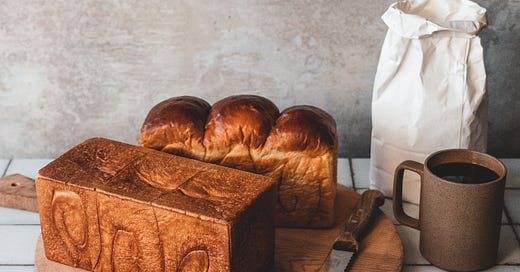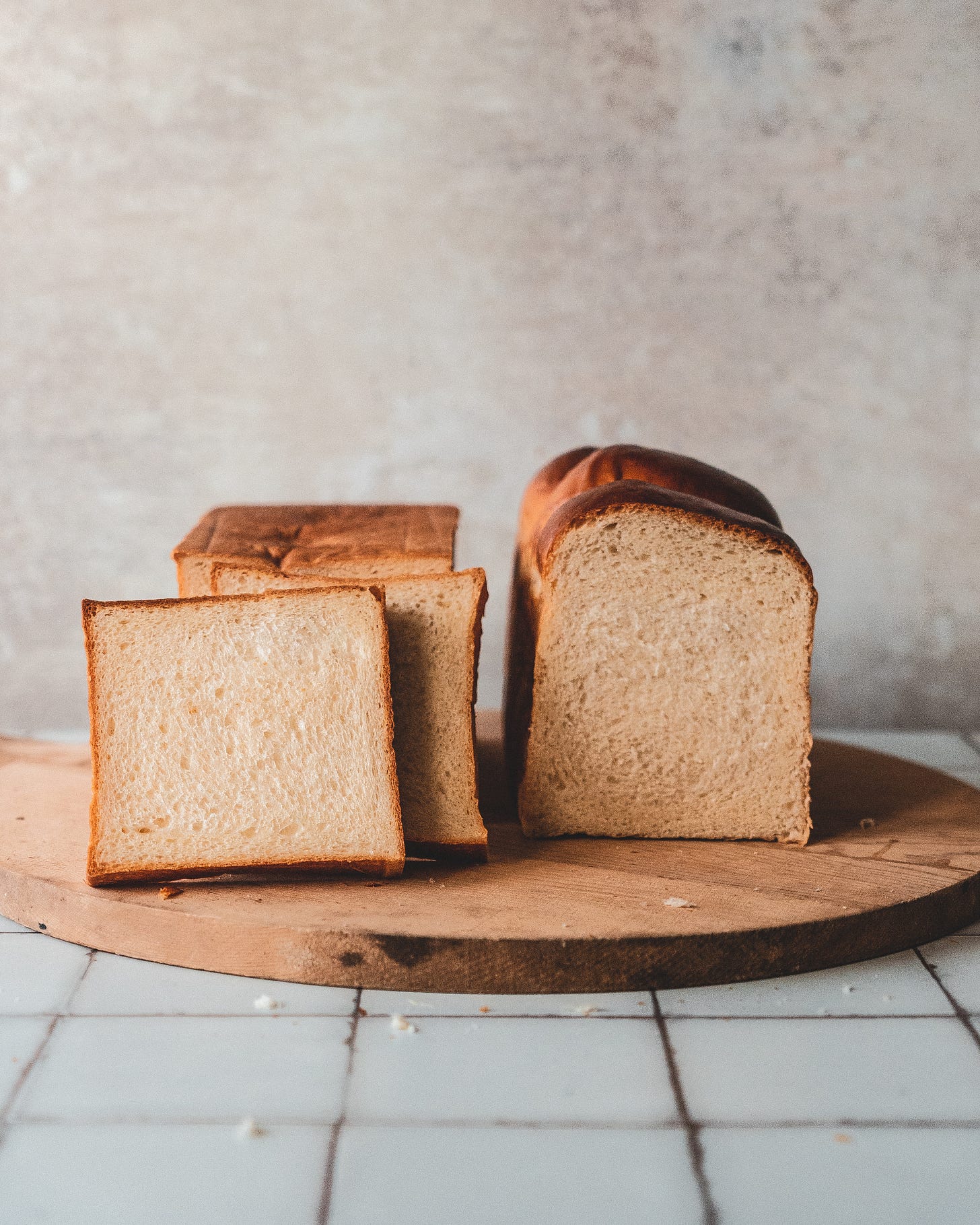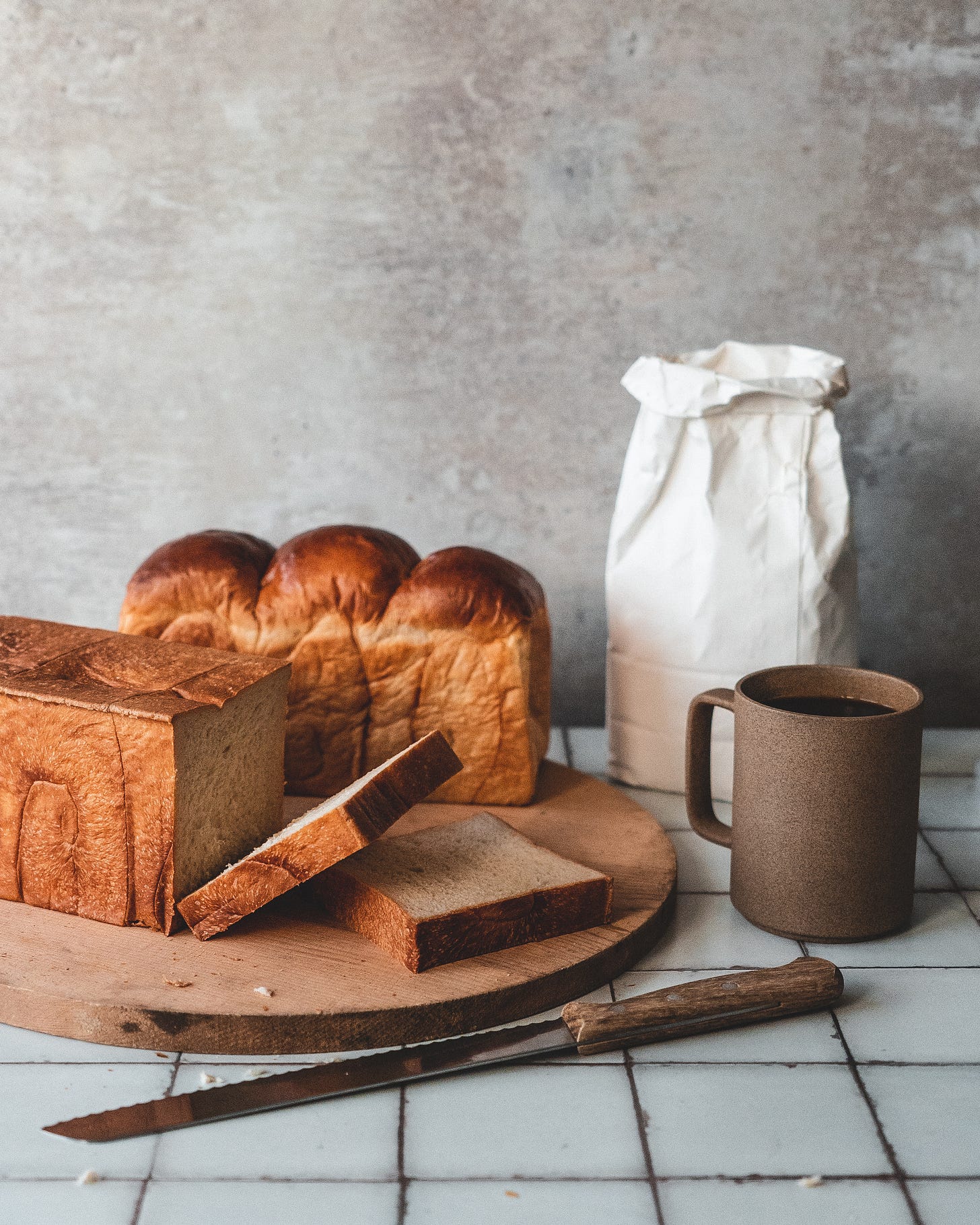🎉This is a post which was previously only for paid subscribers but which has been unlocked to give you an example of what you can expect should you become a paid subscriber. Free subscribers get occasional posts and recipes but paod subscribers get a weekly exclusive recipe in their inboxes every friday. If you fancy a delicious reecipe in your inbox every week then become a paid subscriber for just £5 a month. Not only will get thee weekly newsletter youll also unlock access to the entire newsletter archive and every recipe that is included 🎉
Do you remember bread face? That strange instagram account, which went viral for a while, which was just a woman smashing her face into different bread products? Well, if the desire to do something similar ever crosses my mind, this is the bread I would want to use, it’s the lightest, pillowiest bread you’ll ever come across.
If you’ve ever been to Japan you will immediately recognise this style of bread, it’s incredibly popular and you’ll see it on sale everywhere from high end bakeries, stores inside subway stations and even at convince stores like 7-Eleven. Shokupan is, at its heart, an incredibly fluffy white bread. It has a touch of sweetness and is enriched with butter (sometimes eggs too) and is most often sold in a square format, baked in pullman style loaf pans (square straight sides and with a lid to fully enclose the dough). What makes this style of dough different from any other simple white bread dough is the addition of something called tangzhong or yudane.
Tangzhong vs Yudane
Tangzhong and Yudane are different names for what is essentially the same thing, a roux made with water and flour or in this case milk and flour. When you make bread you’ll know that the more water you add, the stickier and harder to handle the bread dough becomes. If you use some of the liquid to make a roux, you can actually up the hydration without making the dough hard to handle, as the starch in the flour gelatinises, the water is absorbed therefore preventing the dough becoming any slacker. This recipe, for example, has a hydration level of 74% but when its kneaded, and you’re handling it, you’d never know, it feels like a dough with a significantly lower hydration level. The result of making a bread this way is a loaf that is incredibly light and soft but a loaf that also stays that way for longer.
Tangzhong is the Chinese name for this method and Yudane is the Japanese name. After the method was popularised by the Taiwanese author Yvonne Chen, in her 2007 book ‘65C Tangzhong Bread’, the Mandarin name has become the dominant term used in English when describing this method. Whilst the names are often used interchangeably there is actually a difference in the two methods. In the tangzhong, flour and liquid are mixed in a saucepan and cooked to form a paste. Yudane is made simply by pouring the hot liquid over the flour and mixing together to create a paste. Personally I have always used the tangzhong method but both achieve a similar end result in the bread.
To make the recipe below you’ll need one or two pullman pans that measure 9x4x4. If you’re in the UK the brilliant Rackmaster (a metal fabricator that supplies commercial bakeries with various types of equipment) sells a brilliant set of two for just £22 (FYI you order the pan and lids separately). This size pan is smaller than a traditional loaf of shokupan but it is the most common size of pullman pan available outside of Japan. USA Pan also make pans in this style and size but they’re more expensive.
Shokupan
Makes 2 loaves
700g strong white bread flour
520ml whole milk, chilled
12g fine salt
10g fast action dried yeast
2 tbsp honey
100g unsalted butter, room temperature
To make the tangzhong/roux add 50g of the flour and 125ml of the milk to a small saucepan and place over medium heat. Cook, whilst stirring constantly, until the mixture thickens to a paste like consistency. We need this paste to cool and there are two ways to do this, scrape the paste into a small bowl and cover with clingfilm (pressing onto the paste to prevent a skin from forming) and set aside for 30 minutes, or my preferred method, which is to add the paste to the remainder of your cold liquid. The latter method cools the paste and also warms up the milk making it the perfect temperature for bread making.
Add the remaining flour, salt and yeast to the bowl of your stand mixer and mix briefly to combine. Pour the milk, tangzhong paste and honey into the flour mixture and using the dough hook mix to form a shaggy dough. On low/medium speed, knead the dough for 8-10 minutes or until smooth and elastic. With the mixer still running, add the butter and couple pieces at a time and knead until the butter is fully incorporated and the dough is once again smooth elastic, another 8-10 minutes. The finished dough should be able to pass the windowpane test. Place the dough into a lightly greased container and cover, setting aside until the dough has doubled in size. Depending on the room temperature this should take 1-2 hours.
Remove the risen dough and knock back to deflate. Divide into two equal pieces and then each piece into 3. Form each piece of dough into a round and cover with a kitchen towel, setting aside for 15-20 minutes to relax the dough.
To prepare the pullman pans we need to lightly grease them. You can do this with softened butter or, as is my preference, use a cake release spray to ensure the entire pan, and lid, is evenly coated. Working with one piece of dough at a time, roll out into a rectangle that is roughly 15x25cm. Fold the dough in thirds (as above) and then roll up like a Swiss roll. With the end of the roll facing down, place into one of the prepared pans. Repeat with all of the pieces of dough, placing three pieces of dough into each pan. This rolling stage may seem unnecessary but the shaping is done in this manner to add extra structure to dough, helping the bread hold its shape as it bakes. If making a square loaf add the lid, if making a rounded top loaf just cover the pan with clingfilm. Set aside for 1-2 hours or until the top of the dough is about 2cm from the top of the pan. With the rounded top loaf you can push the second rise a little further but with the square loaf you need to be careful because if you proof the loaf any further it could get stuck inside the pan.
When the bread is almost finished rising pre-heat the oven to 210ºC (190ºC Fan).
If you like you can brush the rounded top loaf with egg wash to give a pleasing shiny finish, but this is optional. Bake the rounded top loaf for 30 minutes and the square loaf for 35 minutes. The colour of the baked rounded loaf will be a deep golden brown, like a good French brioche.
When you remove the loaves from the oven give them a firm couple taps on the worksurface and then turn out onto a wire rack to cool completely. This tapping helps to loosen the loaves from the pan and also helps to prevent shrinking. For the square loaf do the same tapping motion before you slide of the lid. Shrinking can also be caused by slight underbaking or over proofing of the dough. When underbaked the loaf has more moisture left which causes shrinkage, when over proofed the dough starts to loose its strength so can collapse a little as the bread cools.
Allow to fully cool before slicing. Store the cooled loaves in plastic bread bags, or slice and freeze for use at a later date.
Tip: if making a square loaf, utilising the lid of the pullman pan, and you end up with a loaf with a teensy muffin top where it has pushed up into the lid, this is generally you took the second proof of the loaf a little too far and you need to bake the loaf a little earlier next time.








Thank you very much
I applied the recipe but I didn't get the brown color of the bread, so the amount of dough for the mold is very large! How much is each piece supposed to weigh